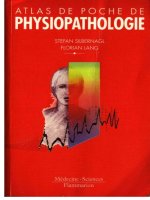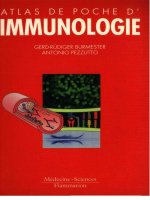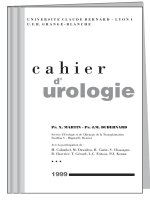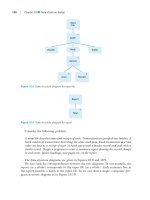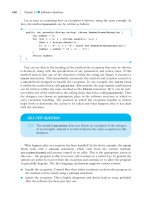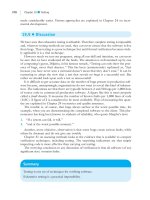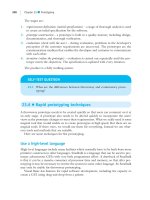Toxicology A Case-Oriented Approach - part 1 pdf
Bạn đang xem bản rút gọn của tài liệu. Xem và tải ngay bản đầy đủ của tài liệu tại đây (247.33 KB, 12 trang )
TOXICOLOGY
A Case-Oriented
Approach
CRC PRESS
Boca Raton London New York Washington, D.C.
John Joseph Fenton
TOXICOLOGY
A Case-Oriented
Approach
This book contains information obtained from authentic and highly regarded sources. Reprinted material
is quoted with permission, and sources are indicated. A wide variety of references are listed. Reasonable
efforts have been made to publish reliable data and information, but the author and the publisher cannot
assume responsibility for the validity of all materials or for the consequences of their use.
Neither this book nor any part may be reproduced or transmitted in any form or by any means, electronic
or mechanical, including photocopying, microfilming, and recording, or by any information storage or
retrieval system, without prior permission in writing from the publisher.
The consent of CRC Press LLC does not extend to copying for general distribution, for promotion, for
creating new works, or for resale. Specific permission must be obtained in writing from CRC Press LLC
for such copying.
Direct all inquiries to CRC Press LLC, 2000 N.W. Corporate Blvd., Boca Raton, Florida 33431.
Trademark Notice:
Product or corporate names may be trademarks or registered trademarks, and are
used only for identification and explanation, without intent to infringe.
Visit the CRC Press Web site at www.crcpress.com
© 2002 by CRC Press LLC
No claim to original U.S. Government works
International Standard Book Number 0-8493-0371-0
Library of Congress Card Number 2001035682
Printed in the United States of America 1 2 3 4 5 6 7 8 9 0
Printed on acid-free paper
Library of Congress Cataloging-in-Publication Data
Fenton, John Ph.D.
Toxicology : a case-oriented approach / John Fenton.
p. cm.
Includes bibliographical references and index.
ISBN 0-8493-0371-0 (alk. paper)
1. Toxicology Case studies. I. Title.
[DNLM: 1. Toxicology Case Report. Poisons Case Report. QV 600 F342t 2001]
RA1219 .F46 2001
615.9
′
07—dc21 2001035682
CIP
0371 fm frame Page 4 Wednesday, August 29, 2001 11:20 AM
Preface
This book is an outgrowth of the author’s experience teaching a toxicology course
for 12 years at West Chester University and his interactions with physicans and
laboratory toxicologists for 24 years in the Crozer Keystone Health System. These
experiences provided valuable insights into the needs both groups have for an
enhanced understanding of toxicology in the laboratory and in the emergency depart-
ment. Accordingly, the present volume was written in hopes of meeting the require-
ments of both physicians and laboratory toxicologists by presenting the analytic and
clinical aspects of toxicology.
Many excellent books are available that address the diagnosis and treatment of
the overdose patient. Other fine volumes, intended for a scientific audience, have
been written that provide test methods and explanations of instrumental modalities
for toxicology testing. The present book is the only one, to the author’s knowledge,
that speaks equally to both audiences, the caregiver and the analytical scientist. The
reader will find that this book, although less clinical than medical toxicology texts,
and less chemical than analytical works, is, nevertheless, heavily vested in both
clinical and analytical aspects of toxicology. Scientists can provide better test results
if they understand the problems of the clinician. Physicians can employ the labora-
tory more effectively if they understand the nature, power, and limitations of toxi-
cology testing. We hope that this book will meet these needs.
Case studies are a popular and effective means of teaching concepts. Pedagogic
research has shown that people tend to remember information that is presented in
the form of case studies. Students also enjoy the narrative approach characteristic
of such studies. Accordingly, the present volume features a very large number of
case studies, all of which are cross-referenced to the clinical literature. They were
selected for their interest and their ability to teach important aspects of toxicology.
The reader is challenged in each case to identify an unknown toxin and may, in fact,
make the identification on the basis of his/her knowledge of symptoms, physical
properties of toxins, and so on. The level of medical knowledge required to fully
understand each case presented here is not insignificant. Some students who have
very little clinical experience will find them very challenging. It is the author’s belief,
however, that even without a complete understanding of every aspect of each clinical
history presented here, one can derive a great deal of benefit by reading the case
studies and trying to answer the questions and problems.
The author has endeavored to maintain the reader’s interest in other ways as
well. For example, many interesting anecdotes from the history of toxicology are
found throughout the text. The alleged arsenical poisonings of Napoleon and of
President Taylor, the probable mercury overdose of Isaac Newton, and the hemlock
ingestion of Socrates are just a few examples of the many famous facts or fiction
0371 fm frame Page 5 Monday, August 27, 2001 1:35 PM
that are part of the history of toxicology. Such events teach us about the nature of
life in the past and the specific dangers that toxins presented to our ancestors.
The author wishes to thank the many who have contributed to his teaching and
toxicology experiences. It has always been a pleasure working with young people
as they start their careers in science. I have also been continuously impressed by
the dedication and effort that the toxicology staff at Crozer Keystone Health System
brought to their jobs everyday. In their company and that of many other members
of the hospital staff we learned toxicology in the “real world.”
John Fenton, Ph.D.
Philadelphia
0371 fm frame Page 6 Monday, August 27, 2001 1:35 PM
Dedication
to Marjorie
0371 fm frame Page 7 Monday, August 27, 2001 1:35 PM
Table of Contents
Chapter 1
History of Toxicology
Chapter 2
Measuring Toxicity
Chapter 3
Therapy
Chapter 4
The Role of the Laboratory in Diagnosis and Treatment of Poisoning
Chapter 5
Introductory Toxicokinetics
Chapter 6
Biotransformation
Chapter 7
Hepatic Toxicity
Chapter 8
Renal Toxicology
Chapter 9
Cardiac Toxicity
Chapter 10
Neurological Toxicity
Chapter 11
Pulmonary Toxicology
Chapter 12
Drug Testing: Screening
0371 fm frame Page 9 Monday, August 27, 2001 1:35 PM
Chapter 13
Confirmatory Tests in Toxicology
Chapter 14
Metal Analysis (Assay of Toxic Metals)
Chapter 15
Alcohols
Chapter 16
Toxic Gases
Chapter 17
Insecticides
Chapter 18
Metals
Chapter 19
Over-the-Counter Analgesics
Chapter 20
Drugs of Abuse
Chapter 21
Sedatives and Hypnotics
Chapter 22
Stimulants
Chapter 23
Anticholinergic Drugs
Chapter 24
Psychedelic Drugs
Chapter 25
Plants
Chapter 26
Snake Venoms
0371 fm frame Page 10 Monday, August 27, 2001 1:35 PM
© 2002 by CRC Press LLC
History of Toxicology
CONTENTS
Ancient Times
Antidotes
Middle Ages
Poisoners
Advances in Toxicology
Therapy
Modern Toxicology
The Problem of Poisoning
Poison Control Centers
Interpretation of PCC Data
References
Questions and Exercises
ANCIENT TIMES
The history of poisons dates to earliest times. Ancient man undoubtedly observed
toxic effects in nature partly on a serendipitous basis as, for example, when he noted
a harmful or fatal effect follow the casual ingestion of some plant or animal product
by one of his fellow tribesmen. But serendipity was not the only mechanism of
discovery. Assuredly, man experimented with natural products in an effort to improve
his arsenal of weapons, the better to achieve success when waging war with his
enemies.
Modern toxicology is characterized by extremely sophisticated scientific inves-
tigation and evaluation of toxic exposures of all kinds. To a large degree this has
been made possible by the widespread application of computers to analytical equip
-
ment. Coupled with other chemical and electronic innovations modern instruments
can detect quantities of toxins that are much smaller than those that could be
measured in the past. Analytic methods are not only highly sensitive but they are
also capable of extreme specificity so that compounds can be implicated in poisoning
episodes to the near certain exclusion of other highly similar compounds. In the
course of this text the reader will learn to appreciate the sophistication and applica
-
tion of technologies such as chromatography-mass spectrometry, inductively coupled
plasmas, and many of the novel ways that antibodies have been employed to allow
rapid and sensitive drug detection.
In modern times most poisoning episodes relate to synthetic products. Obviously,
at an earlier and simpler time before technology permitted us to make better toxins,
1
© 2002 by CRC Press LLC
Measuring Toxicity
CONTENTS
Qualitative Descriptions of Toxicity
Exposure Limits
Determination of LD
50
and Graphical Representations
ED
50
and LD
50
Units in Toxicology
Problems
QUALITATIVE DESCRIPTIONS OF TOXICITY
There are many ways to express the relative toxicity of a substance. In one of the
simplest methods, toxins have been divided into six groups (Table
2.1).
There are several shortcomings in the above qualitative description of relative
toxicity. One such weakness is the width of each category. A second problem is the
imprecision of the terminology. The term supertoxin, for example, is not clear.
An alternative semi-quantitative description which has the advantage of showing
the extremes of toxicity is depicted in Table
2.2. This shows that the lethality of
known substances can vary over an incredibly wide range of 10 orders of magnitude,
extending from ethyl alcohol (which is not entirely innocuous) to botulinus toxin.
These categorizations are helpful only in providing an approximate idea of
relative toxicity. While they allow one to appreciate relative magnitudes of toxicity,
they avoid the inherent complexity of the subject.
The LD
50
is the main statistic used in most toxicology studies. It is described
in greater depth below. For now, it is sufficient to state that it represents the dose
of a toxin which will kill 50% of a group of test subjects. While this is a valuable
quantity to be aware of it is inadequate in terms of fully understanding the inherent
danger present in certain substances. For one thing, the LD
50
describes only one
end-point, death. Organ damage, cancer induction, and other dangers present in
substances, while they are less serious outcomes than death are, nevertheless,
extremely undesirable. If a substance has a low LD
50
, we suspect that it is also
dangerous to health in exposures below the LD
50
. While this is usually true, it does
not clearly define the problem. In other words, there are many substances to which
we are exposed in amounts well below the LD
50
. If the exposure is several orders
of magnitude less than the LD
50
we might, perhaps, feel entirely safe. This is
inappropriate because the potential for health damage to a degree which falls short
of killing a subject cannot be predicted on the basis of the LD
50
. A second problem
with the LD
50
is that it has a large uncertainty associated with it even in the prediction
2
© 2002 by CRC Press LLC
Therapy
CONTENTS
Approach to Treatment
History and Physical Examination
Management
Decontamination
Emesis (Vomiting)
Orogastric Lavage
Activated Charcoal
Whole Bowel Irrigation
Enhanced Elimination
Dialysis and Hemoperfusion
Antidotes
Questions and Exercises
Reference
The primary goal of this book is to understand toxicology from a scientific perspective.
It is not intended to be a guide toward treatment, an area which is covered in much
greater detail in other fine texts. Therefore, this chapter deals with treatment in a brief
manner with the emphasis on the scientific aspects of the therapy of poisoning.
APPROACH TO TREATMENT
The first step in the treatment of a potential poisoning is the stabilization of the
patient. The attending physician must assure that the patient’s vital functions are
Stages in Work-Up of
Suspected Poisoning
Evaluation
Stabilization
History and physical
Toxidrome?
Laboratory testing
Management
Decontamination
Enhanced elimination
Administration of antidote
3
© 2002 by CRC Press LLC
The Role of the Laboratory
in
Diagnosis and
Treatment of Poisoning
CONTENTS
Current Practices
Value and Limitations of Laboratory Testing
Laboratory Accuracy or Error
Outcome Studies
The Structure of Clinical Toxicology Testing
Questions
References
CURRENT PRACTICES
There is a wide disparity in the emphasis placed on toxicology testing in modern
hospitals. Some hospitals have extensive toxicology testing with relatively sophis
-
ticated instruments that are dedicated to the detection and measurement of poisons.
Many others do little or no testing for poisons except for those toxins that are very
common or a part of routine medical practice. This latter group of laboratories would
test, for example, for digoxin, a cardioactive drug that is often involved in overdoses.
Such labs might also test for the most common drugs of abuse. These tests would
be urine-based, qualitative, and usually less than 100% specific. Why is there little
uniformity among healthcare institutions in regard to the extent of their test menus?
This is, to some extent, a function of the specific mission of the medical center. For
example, an urban institution located where drug abuse is a severe problem would
be more likely to develop elaborate toxicology laboratory facilities. Further, the
directors of laboratory facilities do not always agree on what the precise role of drug
testing should be. Opinions differ. Some pathologists and laboratory scientists have
great faith in the ability of the toxicology laboratory to help the attending physician.
Other laboratory directors are of the opinion that limited medical resources are better
directed at other areas.
4
